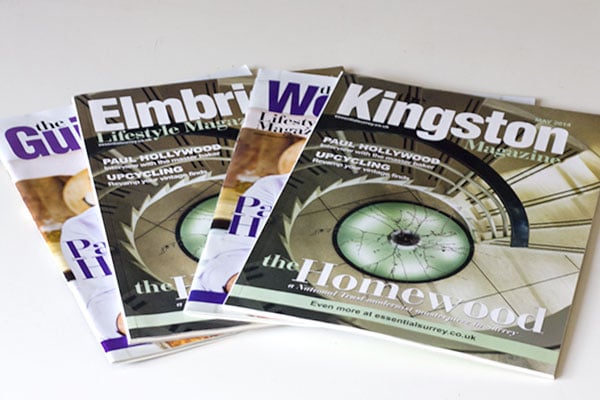Essential Surrey, May 2014

In May, I wrote an article about The Homewood, one of only two Modernist National Trust properties, for Elmbridge Lifestyle Magazine. It ended up being run right across Essential Surrey’s portfolio including The Guildford Magazine, The Kingston Magazine, The Woking Lifestyle Magazine and on their website – it even beat Paul Hollywood to the cover on two of the four magazines! (All copy as submitted.)

A Modernist masterpiece on your doorstep
Following the closure of High Cross House in Devon due to a lack of visitors, it’s more important than ever to visit the National Trust properties on our doorsteps. High Cross House was designed by Swiss-American architect William Lescaze in 1932 and is considered to be one of the UK’s finest examples of Modernist architecture. Characterised by the idea that ‘forms follows function,’ Modernism has shaped the way we live today.
The National Trust leased High Cross House from Dartington Hall Trust and needed 32,000 visitors a year in order for it to be financially sustainable. Unfortunately in 2012, only 21,000 people visited.
The National Trust owns two other Modernist properties and luckily for residents of Surrey, one of them is in Esher. Daniel Duthie, National Trust General Manager of the Surrey Landscapes portfolio said, “The Homewood is a masterpiece of Modernist design in Surrey and we love welcoming visitors to this special place. The National Trust is one of the largest conservation charities in Europe and we are grateful for the support of members and visitors.”
The Homewood is not only a striking example of early British Modernism by talented young architect, Patrick Gwynne, it’s also a record of his life, giving it a cotemporary edge often lacking in stately homes. When Gwynne left the Homewood to the National Trust, he stipulated that a family must always live in it, so it’s also a home to this day. The current tenant David Scott says, “In 2006, I was at a career crossroads. I was looking for something unusual and wanted to be around more for my daughter. I have always been interested in 1930s architecture, so when I saw a National Trust advertisement seeking a tenant for The Homewood, it fitted the bill perfectly.”
Gwynne designed the Homewood in 1937, aged 24, as a home for his parents, himself and his sister. It replaced their Victorian villa on the same plot, and was completed in 1938. The family celebrated with a party – Pimms was followed by dinner on the terrace. For a year “we danced like mad,” said Gwynne. Great entertainers, they made full use of the living room’s sprung floor and built-in gramophone.
But the house’s role as a lively family home was to be short-lived. In 1939, World War Two broke out. Gwynne’s father rejoined the Navy, Gwynne signed up to the RAF and his sister became a WREN. The house was let out during the war, and both of his parents died before peace was declared. Gwynne returned after the war and lived and worked in the Homewood until his death at 90 in 2003.
What makes the property particularly interesting is that Patrick used it as a testing ground for new ideas throughout his career, so rather than capturing a moment in time, it continued to evolve in the spirit of Modernism. In the 1960s he designed the beige sofa in the living room, using the very latest material, ‘leatherette’. His downstairs office looks more like a 1980s James Bond set than something Modernist architect Le Corbusier might have approved of. Towards the end of his life he worked closely with the National Trust on a complete restoration, specifying some very contemporary colours for his new tenants.
“The biggest challenge is the cold,” says current tenant David Scott. “Four-inch concrete, plate glass windows and warm-air heating mean that the average temperature is 16 degrees in the winter. Patrick hated the look of radiators and would have loved underfloor heating, but the technology wasn’t available then. That’s the only thing I would change.”
Cold as it may be, the dramatic wall of glass that lines the living room is one of the defining features of the house. Three identical floor-to-ceiling windows are each divided into three panes, framing the view of the grounds perfectly. “The garden is constantly inspiring,” says David. “Its ten acres include woodland, heathland, shrubbery, formal beds and water features. I love how intensely you experience each season here.”
It’s a house that demonstrates not only what Modernism was, but though Patrick’s continual experimentation and his insistence that it remains lived in, what Modernism aspired to be. “I didn’t meet Patrick when he was alive,” says David, “but if I could say one thing to him, I would tell him how much The Homewood continues to inspire people.”
Entry to the Homewood is by pre-booked guided tour. Tours can be booked on the 1st and 3rd Friday and the 2nd and 4th Saturday of every month from April to October. Each tour takes 45 minutes and they take place at 10:30am, 11:30am, 12:30pm, 2pm and 3pm. There is an additional charge for all visitors, including members, of £3.70 (adult) £1.85 (child) for the minibus shuttle from Claremont Landscape Garden. Call 01372 476424 or email thehomewood@nationaltrust.org.uk to book a tour. nationaltrust.org.uk/homewood
All copy is reproduced here as it was supplied by Katie Treggiden to the client or publication.
Recent Posts
Advertisement






